The Sandy Bridge Review: Intel Core i7-2600K, i5-2500K and Core i3-2100 Tested
by Anand Lal Shimpi on January 3, 2011 12:01 AM ESTThe 6-series Platform
At launch Intel is offering two chipset families for Sandy Bridge: P-series and H-series, just like with Lynnfield. The high level differentiation is easy to understand: P-series doesn’t support processor graphics, H-series does.
There are other differences as well. The P67 chipset supports 2x8 CrossFire and SLI while H67 only supports a single x16 slot off of the SNB CPU (the chip has 16 PCIe 2.0 lanes that stem from it).
While H67 allows for memory and graphics overclocking, it doesn’t support any amount of processor overclocking. If you want to overclock your Sandy Bridge, you need a P67 motherboard.
6Gbps
Had SSDs not arrived when they did, I wouldn’t have cared about faster SATA speeds. That’s how it worked after all in the evolution of the hard drive. We’d get a faster ATA or SATA protocol, and nothing would really change. Sure we’d eventually get a drive that could take advantage of more bandwidth, but it was a sluggish evolution that just wasn’t exciting.
SSDs definitely changed all of that. Today there’s only a single 6Gbps consumer SSD on the market—Crucial’s RealSSD C300. By the middle of the year we’ll have at least two more high-end offerings, including SandForce’s SF-2000. All of these SSDs will be able to fully saturate a 3Gbps SATA interface in real world scenarios.
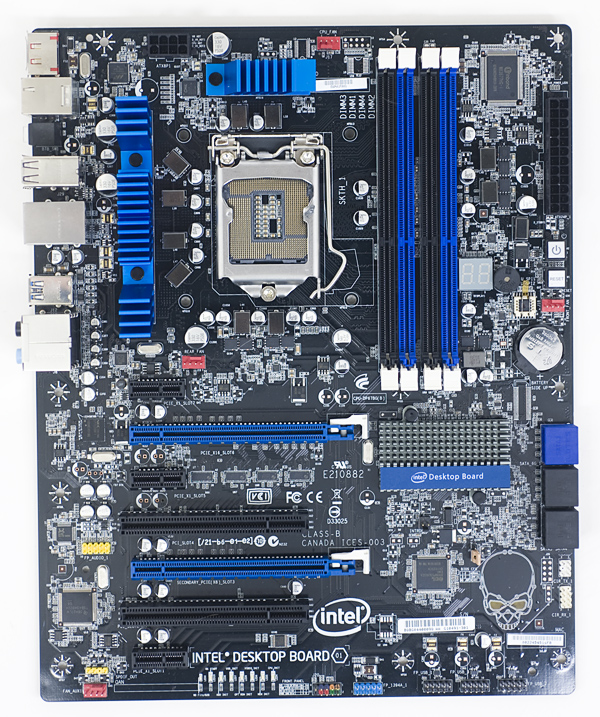
Intel's DP67BG—The blue SATA ports on the right are 6Gbps, the black ones are 3Gbps
To meet the soon to be growing need for 6Gbps SATA ports Intel outfits the 6-series PCH with two 6Gbps SATA ports in addition to its four 3Gbps SATA ports.
I dusted off my 128GB RealSSD C300 and ran it through a bunch of tests on five different platforms: Intel’s X58 (3Gbps), Intel’s P67 (3Gbps and 6Gbps), AMD’s 890GX (6Gbps) and Intel’s X58 with a Marvell 9128 6Gbps SATA controller. The Marvell 91xx controller is what you’ll find on most 5-series motherboards with 6Gbps SATA support.
I ran sequential read/write and random read/write tests, at a queue depth of 32 to really stress the limits of each chipset’s SATA protocol implementation. I ran the sequential tests for a minute straight and the random tests for three minutes. I tested a multitude of block sizes ranging from 512-bytes all the way up to 32KB. All transfers were 4KB aligned to simulate access in a modern OS. Each benchmark started at LBA 0 and was allowed to use the entire LBA space for accesses. The SSD was TRIMed between runs involving writes.
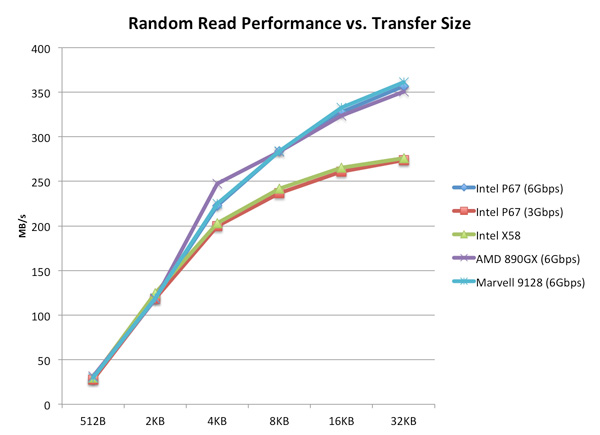
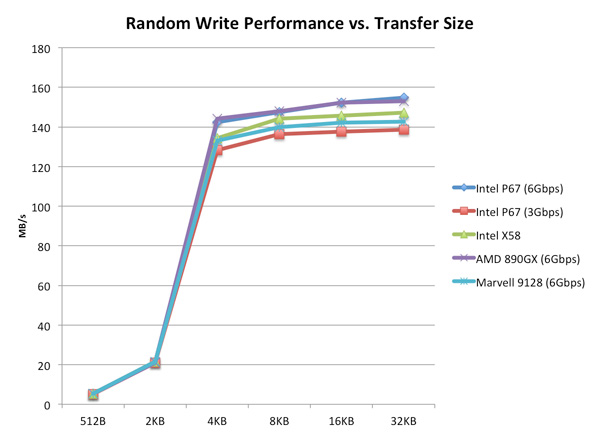
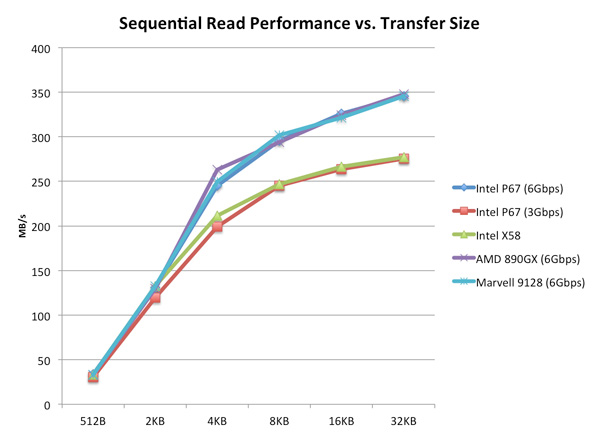
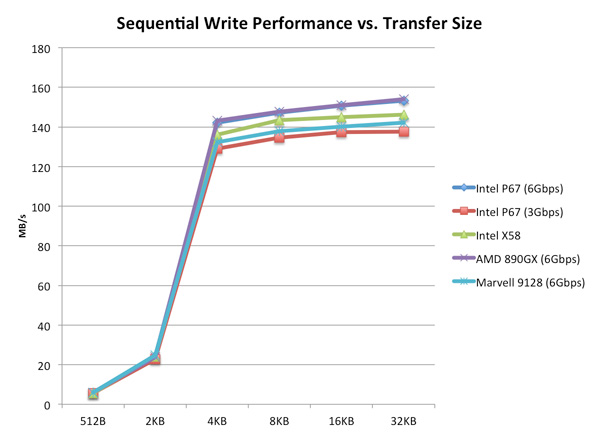
Among Intel chipsets I found that the X58 has stellar 3Gbps SATA performance, which is why I standardize on it for my SSD testbed. Even compared to the new 6-series platform there are slight advantages at high queue depths to the X58 vs. Intel’s latest chipsets.
Looking at 6Gbps performance though there’s no comparison, the X58 is dated in this respect. Thankfully all of the contenders do well in our 6Gbps tests. AMD’s 8-series platform is a bit faster at certain block sizes but for the most part it, Intel’s 6-series and Marvell’s 91xx controllers perform identically.
I hate to be a bore but when it comes to SATA controllers an uneventful experience is probably the best you can hope for.


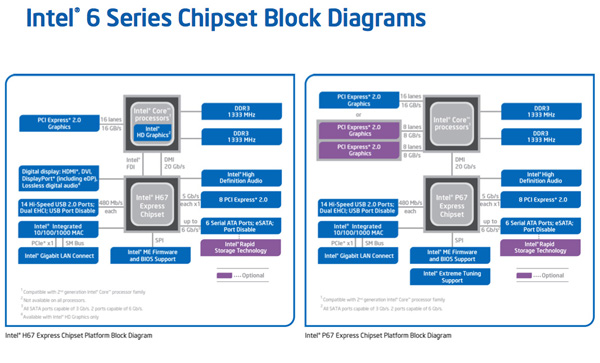








283 Comments
View All Comments
Loki726 - Monday, January 3, 2011 - link
Thanks a ton Anand for adding a compiler benchmark. I spent the vast majority of my time on builds and this will help me spec out a few new machines. It's interesting to see results indicating that I should not go anywhere near a low-end Sandybridge system, and that a lot of cheap AMD cores might not be a bad idea.estee - Monday, January 3, 2011 - link
Can't believe the 23.976Hz output bug is still in SB after all this time. Several years ago, the G35 had this issue and Intel proclaimed they'll have a fix for it. Subsequently, G45 still had the problem and even the iCores, but SB? C'mon....it's a big issue for HTPC buffs, because there's too much judder from 1) LCD displays 2) 3:2 cadencing from film to video conversion, so 1:1 (or rather 5:5 for most 120Hz sets) was a must for large screen HPTC setups. Yes, the bitstreaming is good and all, but most folks are content with just 7.1 DD/DTS output. I guess we'll have to wait (again) for iB and cling on to my ol' nVidia 9300 for now. :(mastrdrver - Monday, January 3, 2011 - link
Was just looking at the pictures that are downloadable and comparing and notice a couple of differences. Maybe they are just a driver tweak but I thought I remember ATI and/or nVidia getting slammed in the past for pulling similar tactics.The first thing I notice was when comparing the AA shots in COD. It appears that maybe the Sandy Bridge graphics isn't applying AA to the twigs in the ground. Or is this just an appearance thing where Intel might have a different algorithm that causing this?
The second is a little more obvious to me. In the Dirt 2 pictures I notice that Sandy Bridge is blurring and not clearly rendering the distance objects. The sign to the right side is what caught my eye.
One last thing is the DAO pictures. I've seen someone (in the past) post up pictures of the same exact place in the game. The quality looks a lot better then what Anand has shown and I was wondering if that is correct. I don't have the game so I have no way to confirm.
As always Anand I appreciate the time you and your staff take to do all of your articles and the quality that results. Its just one of the reasons why I've always found myself coming back here ever since the early years of your website.
RagingDragon - Monday, January 3, 2011 - link
Why don't K series parts get the full suite of virtualization features?xxtypersxx - Monday, January 3, 2011 - link
Anand,Great review as always, I love the in depth feature analysis that Anandtech provides.
Bios updates have been released for Gigabyte, Asus, and Intel P67 boards that correct an internal PLL overvolt issue that was artificially limiting overclocks. Users in the thread over at HWbot are reporting that processors that were stuck at 4.8 before are now hitting 5.4ghz.
http://hwbot.org/forum/showthread.php?t=15952
Would you be able to do a quick update on the overclocking results for your chips with the new BIOS updates?
Gothmoth - Monday, January 3, 2011 - link
".....Sandy Bridge will be worth the upgrade for Quick Sync alone."you say that and a few pages before you say it will not work on PC´s with a discreet grafic card.
i don´t know you but videoencoding is done here on performance systems.
system that have discreet GFX cards like a 460 GTX or better.
and i think most enthusiast will buy a P67 mainboard and that would mean NO QUICK SYNC for them.
so please do an update on your review and clarify what exactly happens when you use a P67 mainboard with a discreet GFX card.
will quick sync really don´t work...??
Gothmoth - Monday, January 3, 2011 - link
please make clear how you have tested quick sync in your review.i saw a few comments from people that are confused about your review.
i guess you tested quick sync on an H67 mainboard but i did not notice that you mentioned that in the text.
for my it looks liek intel is screwing the user who buy this 1. generation sandy bridge chipsets.
i will wait for Z68 thats for sure......
Manabu - Monday, January 3, 2011 - link
In the quick sync test I missed a comparison with x264, that is currently the fastest and highest quality encoder for H.264, on an fast CPU. For example, using the presets superfast and very slow (one for speed with reasonable quality, the other for quality with reasonable speed). Also, with an too high bitrate, even the crapiest encoder will look good...I also wanted to see how low you can undervolt an i5-2400 when it has hit the overclocking cap, and how is the power consumption then. The same for the other locked CPUs would be cool too. Also, what is the power consumption of the sandy bridge CPUs running the quick sync hardware encoder?
NJoy - Monday, January 3, 2011 - link
Wow, what a SLAP in AMD's face! The idea they nursed for gazillion years and were set to finally release somewhere this week is brought to you, dear customer, first to the market, with a sudden change in NDA deadline to please you sooner with a hyperperformer from Intel. Who cares that NDAs make an important play in all planning activities, PR, logistics and whatever follows - what matters is that they are first to put the GPU on-die and this is what the average Joe will now know, with a bit of PR, perhaps. Snatch another design win. Hey, AMD, remember that pocket money the court ordered us to pay you? SLAP! And the licence? SLAP! Nicely planned and executed whilst everyone was so distracted with the DAAMIT versus nVidia battles and, ironically, a lack of leaks from the red camp.I just hope Bulldozer will kick some assess, even though I doubt it's really going to happen...
DanNeely - Monday, January 3, 2011 - link
If AMD didn't put a steel toed boot into their own nuts by blowing the original 09Q3 release date for fusion I'd have more sympathy for them. Intel won because they made their launch date while the competition blew theirs by at least half a year.